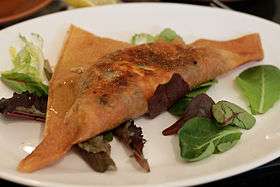Tunisian cuisine
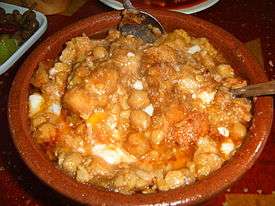
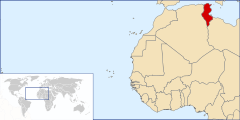
Tunisian cuisine, the cuisine of Tunisia, is a blend of Mediterranean and desert dwellers' culinary traditions. Its distinctive spicy fieriness comes from the many civilizations which have ruled the land now known as Tunisia: Romans, Vandals, Byzantines, Arabs, Spanish, Turkish, Italians, French, and the native Punics-Berber people. Many of the cooking styles and utensils began to take shape when the ancient tribes were nomads. Nomadic people were limited in their cooking implements by what pots and pans they could carry with them. A tagine in Tunisia, is very different from the Moroccan dish. It is a type of a pie dish, made out of eggs, meat and vegetables, similar to the Italian frittata or the eggah. Pork is not traditionally used since its consumption is forbidden in the Sharia, the religious laws of Islam.
The openness to trade and tourism also brought international cuisines, like the Chinese, Indian, Japanese cuisine, or fast-food. Moreover, the intensification of commercial exchanges with Europe and the rest of the world, makes available products until then, unknown or unusual.
Like all countries in the Mediterranean basin, Tunisia offers a "sun cuisine," based mainly on olive oil, spices, tomatoes, seafood and meat.
Ingredients
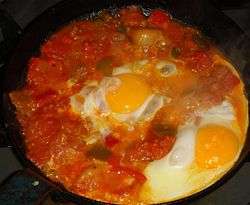
Unlike other North African cuisine, Tunisian food is quite spicy. A popular condiment and ingredient which is used extensively in Tunisian cooking, harissa, is a mix of spices commonly sold together, a paste containing the same spices, or the most important ingredient in the sauce which takes its name from the spices used. Westernised harissa almost always uses red chilies because of the trouble obtaining "black cumin" which is significantly different from standard cumin. Black cumin is readily available in the mediterranean and middle east and there are many people that say harissa is only "real" if it contains black cumin rather than chilies, which are not native to the region.[1] Other common spices include cumin or cumin seeds, garlic, caraway seeds, coriander seeds, and paprika or smoked paprika. A recipe for the sauce includes red chili peppers and garlic, flavoured with coriander, cumin, olive oil and often tomatoes. There is an old wives' tale that says a husband can judge his wife's affections by the amount of hot peppers she uses when preparing his food. If the food becomes bland then a man may believe that his wife no longer loves him. However, when the food is prepared for guests the hot peppers are often toned down to suit the possibly more delicate palate of the visitor. Like harissa or chili peppers, the tomato is also an ingredient integral to the cuisine of Tunisia. Tuna, eggs, olives and various varieties of pasta, cereals, herbs and spices are also ingredients which feature prominently in Tunisian cooking.
Tunisian culinary ingredients include the following typical elements:
- Condiments and flavorings: harissa, rose water, orange blossom water, jasmine water and geranium water.
- Eggs.
- Farm animals: lamb, veal, beef, camel and chicken.
- Fish and seafood: tuna, squid (calamari), octopus, anchovies, eel, sardines, mackerel, red snapper, sea bream, sea snails and sea bass.
- Fruits: lemon, oranges, figs, dates, olives, apricots, pomegranates and quince.
- Herbs: parsley, cilantro, mint, basil, rosemary, oregano, bay leaves and thyme.
- Nuts: hazelnuts, almonds, chestnuts, pine nuts and peanuts.
- Spices: garlic, anise, saffron, cinnamon, caraway, coriander, cumin, fennel, fenugreek, ginger, white pepper, black pepper, red pepper and cloves.
- Vegetables: onions, bell peppers, carrots, chickpeas, tomatoes, capers, celery, turnips, potatoes, chili peppers, cucumbers and eggplants.
- Other popular ingredients: honey.
Tunisians also produce grapes, wheat, barley and orchard fruits, which made into wines (Chateau Mornag of the Tunisian wines), beers (Celtia, Berber or the Stella brand - now owned by Heineken of the Netherlands), brandy (Boukha - fig liqueur, Tbibanine - herbal date liqueur, or other liqueurs made from pomegranates, dates, lotos (jujube), carobs or prickly pears), and apple ciders. Scented waters with dark rose or blossom petals, similar to agua fresca with flowers, have been called "scents from heaven".
Tabil, pronounced "table" is a word in Tunisian Arabic meaning "seasoning " (similar to 'adobo' in Spanish) and now refers to a particular Tunisian spice mix, although earlier it only meant ground coriander. Paula Wolfert makes the plausible claim that tabil is one of the spice mixes brought to Tunisia by Muslims coming from Andalusia in 1492 after the fall of Granada. Today, tabil, closely associated with the cooking of Tunisia, features garlic, cayenne pepper, caraway seeds and coriander pounded in a mortar, then dried in the sun. It is often used in cooking beef, veal and game.
Thanks to its long coastline and numerous fishing ports, Tunisia offers an abundant and varied selection of fish. Most diners in Tunisia are also content to have their fish fillet simply fire-grilled and seasoned with olive oil, a lemon squeeze and salt and pepper to taste. Fish can also be baked, fried in olive oil, stuffed, seasoned with cumin (kamoun). Squid, cuttle fish, and octopus are served in hot crispy batter with slices of lemon, in a cooked salad, or stuffed and served with couscous.
Tunisians also love fire-grilled stuffed vegetables: tomatoes, potatoes, eggplants, bell peppers, squash and turnips.
Although Tunisians do consume dairy products such as milk (hlib), buttermilk (lban), yoghurt (yaghurt) and soft cheeses (rigouta and jban), these dairy products are never used as ingredients in traditional national dishes.
Regional cuisines
Tunisia has different regional aspects. Tunisian cuisine varies from north to south, from the coast to the Atlas Mountains, from urban areas to the countryside, and along religious affiliations.
For instance, the original inhabitants of Tunis (the Beldiya), do not use harissa much; they prefer milder food, and have also developed their own breads and desserts. Their dominant culinary influences are French and Italian and their diet evolves around beef, turkey and chicken.
Closer to the Atlas mountain range, game is favoured. A diet may be composed of quail, pigeons, squabs, partridge, rabbits and hare. In the Cap Bon, people enjoy tuna, anchovies, sardines, sea bass and mackerels. On the island of Djerba, where there is a dense Maghrebim population, only Kosher foodstuffs are consumed. In Hammammet, snails are enjoyed. Organs are traditionally staples of Tunisian cooking, such as tripe, lamb brains, beef liver and fish heads.
Main dishes
Couscous, called "Kosksi", is the national dish of Tunisia, and can be prepared in many ways. It is cooked in a special kind of double boiler called a kiska:s in Arabic or couscoussière in French, resembling a Chinese steamer atop a Mongolian pot.
Meats, vegetables and spices are cooked in the lower pot. Cooking steam rises through vents into the container above. It is layered with whole herbs such as bay leaves and covered with a fine-grain couscous. The couscous pasta is therefore cooked with aromatic steam. During the cooking process, the couscous needs to be regularly stirred with a fork to prevent lumping, as risotto is cooked.
Preferred meats include lamb (kosksi bil ghalmi) or chicken (kosksi bil djaj) but regional substitutes red snapper, grouper (kousksi bil mannani), sea bass (kosksi bil warqua), hare (kosksi bil arnab) or quail (kosksi bil hjall).
Although there are many ways to prepare and compose the dish, a classic recipe would call for the following ingredients: salted butter, bell peppers, shallots, Spanish onions, garlic, potatoes, tomatoes, chickpeas, chili pepper, harissa, celery, cinnamon, black peppercorn, carrots, turnips and squash. The idea is for the dish to contain many vegetables and a variety of Mediterranean ingredients. Contrary to the other north African varieties, the Tunisian couscous is then gently mixed for a few minutes with its sauce, until it colors it integrally.
The first layer consists of a mound of couscous, then a layer of vegetables follows, and finally the meat is positioned on top. The presentation is finished with an additional drizzle of sauce and a sprinkle of fresh parsley, basil or mint (for lamb and mutton couscous).
Substituting orzo, rice, Israeli couscous or barley for fine-grain couscous is not acceptable. In some regions, a medium-grain couscous is seldom used.
Typical Tunisian dishes are brik (a fried Malsouka dough stuffed with tuna and an egg), tajin (like a frittata or a quiche), shorba (soups), slata (salads), marqua (stews), rishta (pastas), samsa (a popular pastry), kifta (ground meat), kaak (pastries), gnawiya (gombos), merguez (lamb sausage) and shakshouka (ratatouille).
Unlike Moroccan tajines, a tajine in Tunisia usually refers to a kind of "quiche", without a crust, made with beaten eggs, grated cheese, meat and various vegetable fillings, and baked like a large cake.
A popular seafood speciality is the 'poisson complet' or the whole fish. The entire fish, excluding internal organs, is prepared and fire-grilled, but it can also be fried, grilled or sautéed. It is accompanied with potato chips and either mild or spicy tastira. The peppers are grilled with a little tomato, a lot of onion and a little garlic, all of which is finely chopped and served with an egg poached or sunny side up. Finely chopped fresh parsley is sprinkled on top; a drizzle of lemon juice and a pinch of sea salt complete the recipe.
Sauces
In Tunisian cuisine, there are no sauces as in classic French cuisine, such as sauce béarnaise, sauce anglaise, sauce allemande or sauce hollandaise. Tunisian sauces, which are closer to spicy broths, are an integral part of the dish. Otherwise olive oils are often used as sauces, such as with the Tuna Fricassee.
This said, harissa or hrissa is often said to be a Tunisian sauce, but it is better described as an ingredient of Tunisian cooking or a seasoning. Harissa is made of red chili, garlic, salt, cumin, coriander, olive oil, and sometimes also caraway or mint.
Two Tunisian sauces deserve mentioning: the Kerkennaise sauce and the Mloukhia. The first is made of capers, olive oil, tomato, scallions, coriander, caraway, cumin, parsley, garlic, white vinegar and paprika. The later is a dark green sauce served with shredded lamb or beef.
Additional dishes and foods
.jpg)
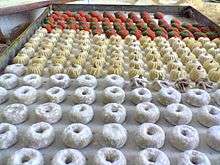
- Asida – a sweet gruel pudding.
- Assidat Zgougou – an Aleppo pine pudding.
- Baklawa – layers of thin pastry interspersed with ground pine nuts, almonds, hazelnuts and pistachios, brushed in golden butter, baked and dipped in a honey syrup.
- Bambalouni – fried sweet donut–like cake served with sugar.
- Berber–style lamb stew – A simple stew of lamb cooked with vegetables, such as potatoes and carrots, in a traditional clay pot.
- Bouza – rich and sticky sorghum puree.
- Brik – tiny parcels of minced lamb, beef, or vegetables and an egg wrapped in thin pastry and deep fried.
- Chakchouka – a vegetarian ragout similar to ratatouille with chickpeas, tomatoes, peppers, garlic and onions, served with a poached egg.
- Chorba – a seasoned broth, with pasta, meatballs, fish, etc.
- Felfel mahchi – Sweet peppers stuffed with meat, usually lamb, and served with harissa sauce.
- Fricasse – tiny sandwich with tuna, harissa, olives and olive oil. It bears no similarity to the classic continental European casserole of the same name.
- Guenaoia – Lamb or beef stew with chillies, okra, and spices.
- Harissa – Harissa is a traditional Tunisian hot chilli paste.
- Houria – cooked carrot salad.
- Kamounia – a beef and cumin stew
- Khobz Tabouna – traditional oven–baked bread. Tunisian Khobz Tabouna is not a flat or pita like bread.
- Koucha – shoulder of lamb cooked with turmeric and cayenne pepper.
- Lablabi – rich garlicky soup made with chickpeas.
- Langues d'oiseaux or "birds' tongues", a type of soup with pasta shaped like rice grains.
- Makroudh – semolina cake stuffed with dates or almonds, cinnamon and grated orange peel.
- Masfouf – sweetened couscous, the Tunisian version of the Moroccan seffa.
- Makboubeh – tomato and pepper stew.
- Makloub – a folded-pizza sandwich, similar to a shawarma, made from pizza dough and filled with minced chicken, cheese, salad, harissa, mayonnaise and other sauces.[2][3]
- Makoud – potato and meat casserole (similar to a quiche).
- Marqa – slow–cooked stews of meat with tomatoes and olives, somewhat similar in concept to the Moroccan tajine stews.
- Mechouia Salad – an hors d'oeuvre of grilled sweet peppers, tomatoes and onions mixed with oil, lemon, tuna fish and hard–boiled eggs.
- Merguez – small spicy sausages.
- Mhalbiya – cake made with rice, nuts and geranium water.
- Mloukhia – a beef or lamb stew with bay leaves, the name is from the green herb used, which produces a thick gravy that has a mucilaginous (somewhat "slimy") texture, similar to cooked okra.
- Noicer pasta – very thin, small squares of pasta made with semolina and all–purpose flour, flavoured with Tunisian Bharat, a blend of ground cinnamon and dried rosebuds.
- Ojja – scrambled egg dish made of tomatoes and mild green chillies supplemented with various meats and harissa.
- Osbane – pieces of animal gut stuffed with meat and offal, a speciality from Monastir.
- Tunisian Salad – diced cucumber, peppers, tomatoes, and onions seasoned with olive oil. Maybe garnished with olives, eggs and tuna. Analogous to the French Niçoise salad and Greek salad.
- Samsa – layers of thin pastry alternated with layers of ground roast almonds, and sesame seeds, baked in lemon and rosewater syrup.
- Shakshouka – a dish of eggs poached in a sauce of tomatoes, chili peppers, and onions, often spiced with cumin.
- Zitounia – ragout of veal or other meats simmered in a tomato sauce with onions, flavoured with olives.
- Torshi – turnips marinated with lime juice.
- Yo-yo – donuts made with orange juice, deep fried, then dipped in honey syrup.
See also
References
- ↑ "Capsicum annuum (chilli pepper)". Kew Royal Botanic Gardens. Retrieved 20 November 2014.
- ↑ Tunisian Makloub
- ↑ Things We Love: Makloub | Better Things Ahead
Further reading
- Tunisian cuisine article, from Vegetarian Times, July 2000 (Google Books)
- Recipe books
- Tunisia Mediterranean Cuisine, by: Konemann ISBN 3-8331-2344-3
External links
- News website Tunisia Live with a section on Tunisian Cuisine
- Tunisian cuisine at Tourism Tunisia
- Focus on Tunisia - Cuisine
- les jasmins de la tunisie
- les recettes des plats tunisiens

